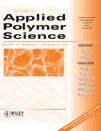Synthesis and characterization of a salt-resisting superabsorbent based on poly(acrylic acid) with sodium tungstate as a crosslinker
Abstract
A novel salt-resistant superabsorbent polymer was synthesized by solution polymerization from the monomer acrylic acid (AA) with potassium persulfate as the initiator. Sodium tungstate was first employed as a crosslinker in the preparation to achieve a better crosslinked polymer (WPAA). In addition to the xerogel WPAA, sodium hydroxide and tris(2-hydroxyethyl)amine (TEA) were introduced for the preparation of WPAA–sodium and WPAA–TEA hydrogels, respectively. The effect on the water absorbency of factors such as the reaction temperature, degree of neutralization of AA, and amounts of the crosslinker sodium tungstate and the initiator were investigated. The crosslinked xerogels were characterized with infrared spectroscopy. These crosslinked superabsorbent composites with sodium tungstate were characterized with thermogravimetric analysis and scanning electron microscopy. The water absorbencies of these superabsorbent composites in water and saline solutions were investigated. Results obtained from this study showed that under the same synthesis conditions, in comparison with superabsorbent composites with an aluminum salt as a crosslinker and styrene as a graft copolymer, the salt resistance of the superabsorbent composite synthesized with sodium tungstate as a crosslinker was obviously enhanced. Moreover, the WPAA–TEA xerogel had absorbency values of 223.6 and 81.9 g/g for distilled water and a 0.9 wt % NaCl solution, respectively, and it showed better salt resistance and a better water-absorbing rate than the WPAA–sodium xerogel because of the modification with triethanolamine. © 2008 Wiley Periodicals, Inc. J Appl Polym Sci, 2008




